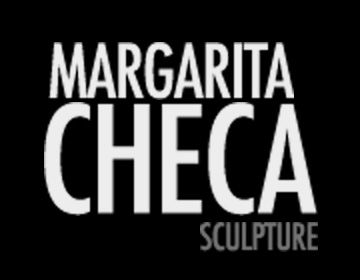MARGARITA CHECA
Lucia de la Puente Gallery
“The earth does not belong to men; it is men who belong to the earth. Everything is connected, like the blood that binds us all. Men did not weave the web of life; it is only the thread of it. What he does to the web, he does to himself.” With these words Margarita Checa (Lima, 1950) explains in a synthetic manner the spirit that encourages “The Web of Life”, the exhibition of her most recent sculptures at Lucia de la Puente gallery. A set of ten sculptures in wood and two in bronze represents a cast of characters in which beats the claim for humanity/human kind – understood as an affirmation of individuality in connection with the dimension of otherness. That is, a respectful relationship “with one another” as well as with “the other” (nature) is perceived in the introspective serenity of these adults – of statures slightly higher than two meters, apart from the ones made of bronze which are of smaller form – and children (of natural height.)
The style of the art pieces responds to the language that the artist has acquired from her professional training at the “Universidad Pontificia Universidad Catolica del Peru” and the Cristina Galvez workshop which was established in the 80’s. A naturalistic representation of the human figure, blended with the stylization of certain parts: dolichocephalic heads and big feet (perhaps as an allusion to the contact to the earth); the components of the ritual meeting gathered in the “galleristic” space question the spectator with their corporal gestures and facial expressions. The catalogue of emotions expressed by the characters extend from the contemplative hieratic attitude to the amazement of living typical of children. The wood – predominantly olive but also other types from the immense Amazon forest– has natural colors with a plain and shiny finish that invite to tactile approach. A distinctive feature of Margarita Checa’s rhetoric is the use of inlays of diverse materials such as bullhorns, wood, Huamanga stone (Andean alabaster), silver, and bronze. Thus, the artist continues with the ancient Peruvian tradition of marquetry, developed in metallurgy since Pre-Columbian times and continued during colonial times in furnishings and other applications.
“The inevitable” illustrates the aforementioned general characteristics. The art piece, of hermetic title, was made in 2008, and combines olive wood and mahogany. The boy represented in a natural scale, but his skull, hands and feet show the stylization performed by our sculptress. The boy carries a sort of bandolier
In which he carries a big fish reminiscent of the Amazonian style. Its scales are fragments of bullhorn, a material that fits in the wood with a harmonic contrast. The contact of the hands of the child and the body of the animal suggests a fruitful coexistence with the natural surroundings (remember: “All is connected”.) The nakedness of the human being exempts him from any specific cultural circumscription: they are representations that establish themselves at a universal level. This disregard for space-time coordinates is what gives a mythical dimension to the characters by Margarita Checa, as far as their problems become transcultural and permanent in time. Even in the presence of clothing (including cloaks, headdresses and bracelets), bodies are never fully covered. The Utopy of the artist, men, women and earth (that “don’t belong to men”, quite the opposite) inseparably constitute the vital framework.
Two small pieces in bronze complement the set of sculptures. The stylization in these pieces is more accentuated than in the ones made of wood; the slenderness of the bodies and the metal texture evoke the language of Giacometti. They wear sobering silver garments – as their pairs in this exhibition -, in contrast to the dark patina of their skin; a sort of christening robe in one case, and a full-length skirt in the other. In spite of their dimensions, these sculptures show a mightiness surely explained by the deliberate disproportion of their limbs. One of them holds the title of the exhibition. Its attitude of sizing up with one hand seems to metaphor the author’s calling to preserve the ability to be amazed by life, to defend the discovery as vocation that cannot be waived.
The initial words reflect a declaration of humility. The man seems to be unaware of his nature as a “symbolic animal” (in Cassirer’s words), to the extent, that, guided by a supposed rationality, threatens the principles of equity towards his fellow men and respect for the environment. In fact, the etymology of “symbol” refers to the ideas of union (in opposition, “diabolo” is the one who divides.) without literal allusions (since an evident “agenda” cannot be perceived), Margarita Checa’s work examines the urgent need of men to gather, in terms of reconciliation with themselves, with one another, and with nature. From the maturity of her proposition, the artist invites us to return to the web of life.
Luis Agusti
Back